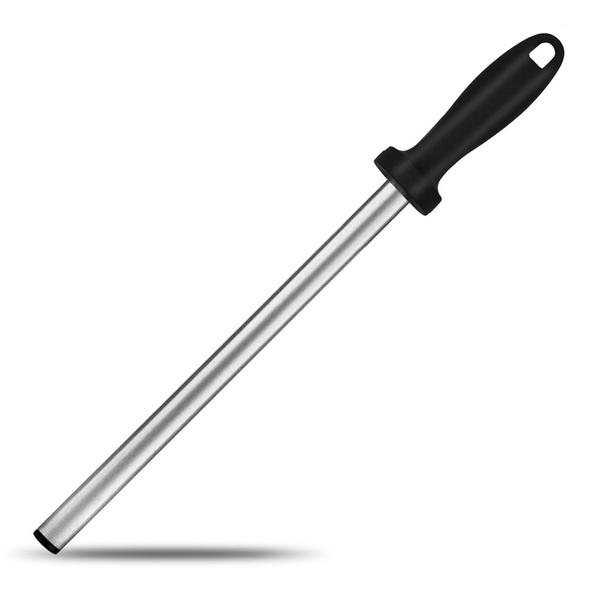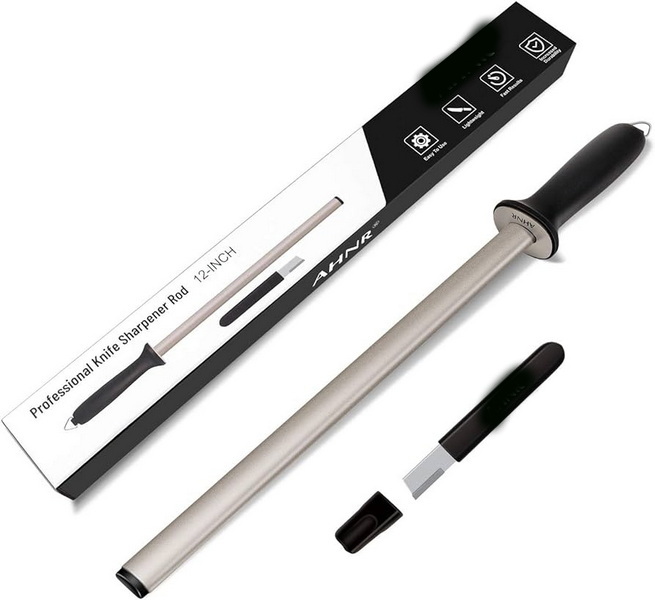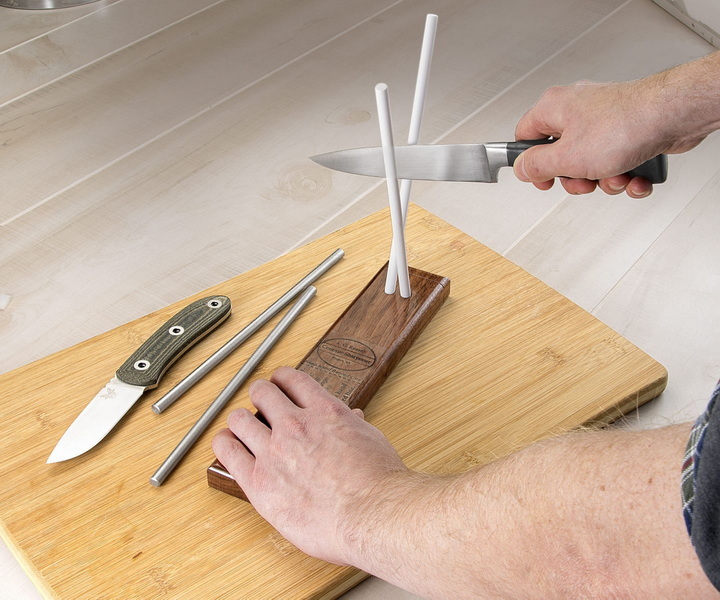Content Menu
● Introduction to Tungsten Carbide
>> Properties of Tungsten Carbide
>> How Tungsten Carbide Works in Sharpening
● Types of Tungsten Carbide Sharpeners
>> Pull-Through Sharpeners
>> Rod-Style Sharpeners
>> Multi-Stage Sharpeners
● How to Use Tungsten Carbide Rods for Knife Sharpening
>> Step-by-Step Guide
>> Tips for Effective Sharpening
● Advantages of Using Tungsten Carbide Sharpeners
>> Speed and Efficiency
>> Ease of Use
>> Portability
>> Cost-Effectiveness
● Disadvantages and Precautions
>> Aggressiveness
>> Limited Precision
>> Potential Damage
>> Not Suitable for All Knives
>> Precautions
● Alternative Sharpening Methods
>> Whetstones
>> Honing Steels
>> Electric Sharpeners
● Maintaining Your Knives
>> Regular Cleaning
>> Proper Storage
>> Periodic Sharpening
>> Professional Sharpening
● Conclusion
● FAQ
>> 1. How often should I sharpen my knives with a tungsten carbide rod?
>> 2. Can I use a tungsten carbide sharpener on all types of knives?
>> 3. How do I clean a tungsten carbide sharpening rod?
>> 4. What angle should I use when sharpening with a tungsten carbide rod?
>> 5. Are tungsten carbide sharpeners better than whetstones?
● Citations:
Tungsten carbide rods have emerged as a popular tool for knife sharpening, lauded for their ability to quickly restore a sharp edge on dull blades[1]. This article delves into the science, application, and best practices of using tungsten carbide rods for knife sharpening, providing a comprehensive guide for both novice and experienced users.

Introduction to Tungsten Carbide
Tungsten carbide (WC) is a compound of tungsten and carbon atoms, known for its exceptional hardness, high melting point, and resistance to wear[2]. These properties make it ideal for various industrial applications, including cutting tools, abrasives, and, more recently, knife sharpeners.
Properties of Tungsten Carbide
- Hardness: Tungsten carbide is one of the hardest materials, often second only to diamond on the hardness scale[2].
- Wear Resistance: It exhibits excellent resistance to abrasion and erosion, ensuring longevity and consistent performance[2].
- High Melting Point: With a melting point of approximately 2,870 °C (5,200 °F), tungsten carbide can withstand high temperatures without losing its structural integrity[2].
- Chemical Stability: It is chemically inert, resisting corrosion and oxidation in most environments[2].
How Tungsten Carbide Works in Sharpening
Tungsten carbide sharpeners typically feature small, precisely angled pieces of tungsten carbide that act as an abrasive[1]. When a knife blade is drawn across these pieces, the sharp carbide edges remove tiny amounts of metal, effectively reshaping the blade's edge and creating a new, sharper cutting surface[5].
Types of Tungsten Carbide Sharpeners
There are several types of tungsten carbide sharpeners available, each designed for specific needs and preferences.
Pull-Through Sharpeners
Pull-through sharpeners are among the most common types, featuring V-shaped slots lined with tungsten carbide inserts[1]. To use, the knife blade is simply pulled through the slot, allowing the carbide edges to grind against the metal.
Advantages:
- Ease of Use: Simple and straightforward, requiring minimal skill.
- Speed: Quickly sharpens a dull blade.
- Portability: Compact and easy to carry.
Disadvantages:
- Aggressiveness: Can remove too much metal, shortening the blade's lifespan[9].
- Limited Control: Fixed sharpening angle may not suit all knives.
- Potential Damage: Risk of chipping or scratching the blade if not used carefully[9].
Rod-Style Sharpeners
Rod-style sharpeners consist of a tungsten carbide rod attached to a handle, similar to a honing steel[1]. These sharpeners offer more control and precision compared to pull-through models.
Advantages:
- Control: Allows for adjusting the sharpening angle.
- Versatility: Suitable for various knife types and blade shapes.
- Portability: Easy to carry and use in different locations.
Disadvantages:
- Technique: Requires some skill and practice to use effectively.
- Aggressiveness: Can still remove metal quickly if too much pressure is applied[3].
- Maintenance: Rod may need occasional cleaning to remove metal buildup.
Multi-Stage Sharpeners
Multi-stage sharpeners combine tungsten carbide with other abrasive materials, such as ceramic or diamond, to provide a more comprehensive sharpening solution[7]. These sharpeners often include separate slots for coarse sharpening, honing, and polishing.
Advantages:
- Comprehensive Sharpening: Addresses multiple aspects of blade maintenance.
- Versatility: Suitable for different types of knives and levels of dullness.
- Ease of Use: Combines the simplicity of pull-through sharpeners with additional features.
Disadvantages:
- Cost: Generally more expensive than single-stage sharpeners.
- Size: Can be bulkier and less portable.
- Complexity: May require some learning to fully utilize all features.

How to Use Tungsten Carbide Rods for Knife Sharpening
Using tungsten carbide rods effectively requires understanding the proper technique and taking necessary precautions.
Step-by-Step Guide
1. Preparation:
- Clean the knife blade to remove any dirt, oil, or debris.
- Secure the sharpening rod on a stable surface or hold it firmly[1].
2. Sharpening:
- Hold the knife at the correct angle, typically between 20 to 30 degrees[4].
- Apply light to moderate pressure and draw the blade across the tungsten carbide rod[1].
- Repeat this motion several times, alternating between both sides of the blade[4].
3. Honing:
- If the sharpener has a honing stage, use it to refine the edge and remove any burrs[5].
- Hold the knife at a slightly steeper angle and draw the blade across the honing surface[5].
- Repeat several times on each side.
4. Testing:
- Carefully test the sharpness of the blade by slicing through a piece of paper or a soft material[4].
- If necessary, repeat the sharpening and honing steps until the desired sharpness is achieved[4].
5. Cleaning:
- Wipe the knife blade clean with a soft cloth to remove any metal particles[1].
- Clean the sharpening rod with a brush or cloth to remove any buildup[1].
Tips for Effective Sharpening
- Maintain a Consistent Angle: Consistency is crucial for achieving a sharp, even edge[4].
- Use Light Pressure: Applying too much pressure can damage the blade and the sharpener[6].
- Alternate Sides: Sharpen both sides of the blade equally to maintain balance[4].
- Keep the Blade Clean: Regularly clean the blade during sharpening to remove metal particles[1].
- Follow the Manufacturer's Instructions: Each sharpener may have specific recommendations for use[1].
Advantages of Using Tungsten Carbide Sharpeners
Tungsten carbide sharpeners offer several advantages that make them a popular choice for knife maintenance.
Speed and Efficiency
One of the primary benefits of tungsten carbide sharpeners is their ability to quickly restore a sharp edge on a dull blade[1]. The abrasive nature of tungsten carbide allows for rapid metal removal, making it an efficient tool for busy individuals who need a sharp knife without spending a lot of time sharpening[5].
Ease of Use
Tungsten carbide sharpeners are generally easy to use, requiring minimal skill or experience[1]. Pull-through models, in particular, are designed for simplicity, making them accessible to novice users who may be intimidated by more complex sharpening methods[5].
Portability
Many tungsten carbide sharpeners are compact and lightweight, making them easy to carry and use in various locations[7]. This portability is especially useful for outdoor enthusiasts, campers, and chefs who need to maintain their knives on the go[1].
Cost-Effectiveness
Compared to other sharpening methods, such as professional sharpening services or high-end sharpening systems, tungsten carbide sharpeners are relatively inexpensive[5]. This makes them a cost-effective option for individuals who want to maintain their knives without investing a significant amount of money[7].
Disadvantages and Precautions
Despite their advantages, tungsten carbide sharpeners also have some drawbacks that users should be aware of.
Aggressiveness
The aggressive nature of tungsten carbide can lead to excessive metal removal, which can shorten the lifespan of the blade[9]. Over time, this can significantly reduce the knife's size and alter its geometry, affecting its performance[9].
Limited Precision
Tungsten carbide sharpeners, especially pull-through models, offer limited control over the sharpening angle[1]. This can result in an uneven or inconsistent edge, particularly on knives with complex blade shapes or specific sharpening requirements[5].
Potential Damage
If not used carefully, tungsten carbide sharpeners can cause chipping, scratching, or other damage to the blade[9]. Applying too much pressure or using the wrong technique can lead to irreversible damage, especially on high-quality knives[6].
Not Suitable for All Knives
Tungsten carbide sharpeners may not be suitable for all types of knives[3]. Knives with very hard or brittle blades, such as those made from ceramic or certain high-carbon steels, may be more prone to damage when sharpened with tungsten carbide[3].
Precautions
- Use Sparingly: Avoid over-sharpening the blade[2].
- Apply Light Pressure: Let the sharpener do the work[6].
- Follow Instructions: Adhere to the manufacturer's guidelines[1].
- Inspect the Blade: Check for any signs of damage after sharpening[4].
- Consider Alternatives: For high-quality knives, consider using a more precise sharpening method[3].
Alternative Sharpening Methods
While tungsten carbide sharpeners offer a convenient solution for quick sharpening, several alternative methods provide greater precision and control.
Whetstones
Whetstones, also known as sharpening stones, are abrasive stones used to sharpen knives and other cutting tools[4]. They come in various grits, ranging from coarse for heavy sharpening to fine for polishing[4].
Advantages:
- Precision: Allows for precise control over the sharpening angle and pressure[4].
- Versatility: Suitable for all types of knives and blade shapes[4].
- Edge Quality: Produces a very sharp and refined edge[4].
Disadvantages:
- Technique: Requires skill and practice to use effectively[4].
- Time: Sharpening with a whetstone can be time-consuming[4].
- Maintenance: Stones need to be kept clean and lubricated[4].
Honing Steels
Honing steels, also known as sharpening steels, are rods made of steel, ceramic, or diamond, used to realign the edge of a knife blade[3]. They do not actually sharpen the blade but rather straighten any microscopic bends or distortions[3].
Advantages:
- Edge Maintenance: Keeps the blade's edge aligned and sharp between sharpenings[3].
- Ease of Use: Simple and quick to use[3].
- Versatility: Suitable for most types of knives[3].
Disadvantages:
- No Sharpening: Does not actually sharpen a dull blade[3].
- Limited Effect: Only effective for minor edge realignment[3].
- Material: The type of steel is important.
Electric Sharpeners
Electric sharpeners use motorized abrasive wheels or belts to sharpen knives quickly and efficiently[2]. They often feature multiple stages for sharpening, honing, and polishing[2].
Advantages:
- Speed: Quickly sharpens a dull blade[2].
- Ease of Use: Requires minimal skill or effort[2].
- Consistency: Provides consistent results[2].
Disadvantages:
- Aggressiveness: Can remove too much metal if not used carefully[2].
- Cost: Generally more expensive than manual sharpeners[2].
- Potential Damage: Risk of overheating or damaging the blade[2].
Maintaining Your Knives
Proper knife maintenance is essential for prolonging the life of your blades and ensuring optimal performance[2].
Regular Cleaning
Clean your knives after each use with warm, soapy water[2]. Avoid using abrasive cleaners or scrub brushes, as they can damage the blade[2]. Dry the knife thoroughly before storing it to prevent rust and corrosion[2].
Proper Storage
Store your knives in a knife block, on a magnetic strip, or in a sheath to protect the blades from damage[2]. Avoid storing knives loose in a drawer, where they can get scratched or dulled[2].
Periodic Sharpening
Sharpen your knives regularly to maintain a sharp edge[4]. The frequency of sharpening depends on how often you use your knives and what types of materials you cut[4]. As a general rule, sharpen your knives whenever they start to feel dull or when they no longer cut cleanly[4].
Professional Sharpening
Consider having your knives professionally sharpened every year or two[5]. Professional sharpeners have the tools and expertise to restore your knives to their original sharpness and correct any damage[5].
Conclusion
Tungsten carbide rods can be a convenient and effective tool for quickly sharpening knives, especially for those seeking a simple and portable solution[1]. However, their aggressive nature and limited precision require careful usage to avoid potential damage and excessive metal removal[9]. For high-quality knives or those requiring a more refined edge, alternative sharpening methods like whetstones or professional services may be more suitable[3]. Proper knife maintenance, including regular cleaning, storage, and periodic sharpening, is crucial for prolonging the life and performance of your blades[2].

FAQ
1. How often should I sharpen my knives with a tungsten carbide rod?
Sharpening frequency depends on usage. Sharpen when the knife feels dull or doesn't cut cleanly. Avoid over-sharpening to prevent excessive metal removal[4][9].
2. Can I use a tungsten carbide sharpener on all types of knives?
Tungsten carbide sharpeners may not be suitable for all knives. Avoid using them on very hard or brittle blades, such as ceramic or certain high-carbon steels, which may be more prone to damage[3].
3. How do I clean a tungsten carbide sharpening rod?
Clean the sharpening rod with a brush or cloth to remove any metal buildup. For stubborn residue, use a mild detergent and water, then dry thoroughly[1].
4. What angle should I use when sharpening with a tungsten carbide rod?
The sharpening angle typically ranges from 20 to 30 degrees. Maintain a consistent angle throughout the sharpening process for an even edge. Refer to the knife manufacturer's recommendations for the optimal angle[4].
5. Are tungsten carbide sharpeners better than whetstones?
Neither is definitively "better"; it depends on the user's needs. Tungsten carbide sharpeners are faster and easier to use, while whetstones offer greater precision and control. For high-quality knives, whetstones are often preferred for a refined edge[4].
Citations:
[1] https://www.sharpeningsupplies.com/products/lansky-tactical-sharpening-rod
[2] https://passionblade.com/what-is-the-best-way-to-sharpen-tungsten-carbide-blade/
[3] https://www.bladeforums.com/threads/tungsten-carbide-rod-for-steeling-knives.1541695/
[4] https://www.youtube.com/watch?v=KRk9_88LfXs
[5] https://warthercutlery.com/products/brod-taylor-tungsten-carbide-sharpener
[6] https://knife.wickededgeusa.com/forums/topic/any-tips-on-sharpening-a-sandrin-tungsten-carbide-blade/
[7] https://zenportusa.com/product/tungsten-carbide-sharpener/
[8] https://www.bladeforums.com/threads/tungsten-carbide-sharpening.1867146/
[9] https://www.reddit.com/r/chefknives/comments/9kxss2/tungsten_carbide_sharpeners/
















